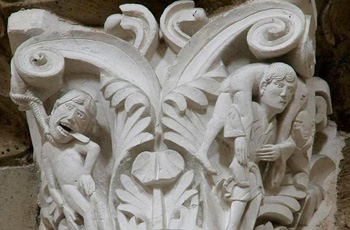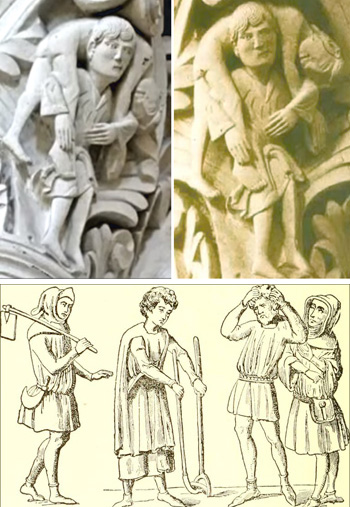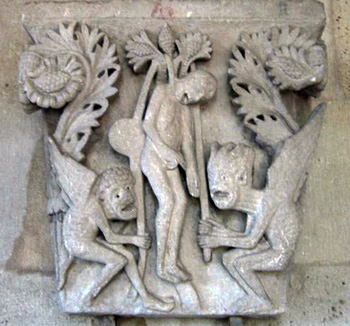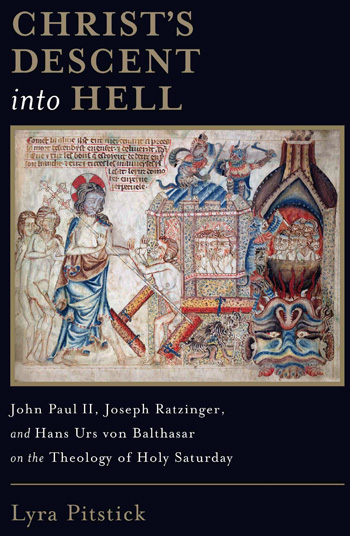What Is Behind Francis’ Rehabilitation of Judas?
Marian T. Horvat, Ph.D.
On three different occasions, Francis has praised Judas publicly, suggesting that the apostle who betrayed Our Lord Jesus Christ is a misunderstood personality and "the end of his story" possibly is not Hell. We should not be surprised since on other occasions the same Pope, assuring us he is following in the tradition of John Paul II, proposes that Hell as a physical place does not exist as well.

A defense of Judas being saved by Christ's mercy
He goes through the story, presenting Judas as "a difficult character to understand": first, he sincerely repents; second, the "righteous ones – the priests – reject him; third, since he "can't find a way out of his situation," he is overcome with a "guilt that suffocates him." A sympathetic portrayal of the traitor Judas, who, according to the Pope, is himself betrayed by the lack of mercy of the "righteous ones," the priests...
Then, he goes on to find a conjectural medieval "proof" for his theory that Judas could be saved: "Perhaps someone might think, ‘this pope is a heretic…’ But, no! They should go see a particular medieval capital of a column in the Basilica of St. Mary Magdalen in Vézelay, Burgundy [France] ... On that capital, on one side there is Judas, hanged; but on the other is the Good Shepherd, who is carrying him on his shoulders and is carrying him away.”

The Judas column that Francis admires and displays behind his office desk
For anyone with a middling knowledge of medieval art and theology, this interpretation is a blatant misrepresentation of History. First the column in the Vézelay Basilica that houses the relics of St. Mary Magdalene is obviously presenting Judas as the traitor and a symbol of horror and offering it for public disdain: His tongue hangs grotesquely out of his mouth and his eyes pop out madly as he hangs from the noose he fashioned for himself in despair.

Medieval peasant clothing - the man on the column is clearly meant to be a worker, not Jesus
The man carrying off the dead body could hardly be the "Good Shepherd," or Jesus Christ, as Pope Bergoglio pretends. By the 11th century Christ was always portrayed in art and sculpture with a divine halo, a beard and invariably dressed in a long robe, the seamless garment Our Lady wove for Him.
This clean-shaven man with his short laborer tunic and without a halo is clearly carrying out the distasteful job of carting off the body of the suicidal Judas who, according to custom, received a shameful burial after dusk. Thus, the worker's "ironic" expression that Francis prefers to interpret as Christ's "complicity" with the crime of Judas has nothing to do with feelings of empathy; instead it simply express the repugnance of that worker in carrying such a disgusting burden.
Francis, so eager to rehabilitate Judas and imagine he could be saved, blatantly falsifies not only the symbolism of the column of Vézelay, but also medieval theology.
Other instances of Francis saving Judas
This is not the first time Francis has tried to save Judas. He brought up this same column in Vézelay Basilica in an interview with the German magazine Zeit of March 8, 2017, using it again as a supposed teaching lesson of medieval theology about the mercy of Christ and possible salvation of Judas.

Another medieval presentation of Judas’ suicide with devils taking his soul - Autun, France - 12th c.
Nothing could be further from Catholic teaching. Since the time of early Church Fathers, the Church judged suicide to be a mortal sin as an act of injustice toward God the Creator and a severe offense against the charity man owes himself. Thus, she condemned this act of despair as a most atrocious crime and denied the person who committed suicide a Christian burial. To this mortal sin Judas added the crime of betraying the Man-God. This was the constant teaching of the monks of the Middle Ages, not the nonsense of Francis.
Finally, in a homily of June 12, 2016 on God's tenderness, Pope Bergoglio describes Judas sympathetically as a "lost sheep" who had repented. “I believe that the Lord will take that word [repentance] and bring it with Him,” he said. This repentance tells us that right until the end "God’s love was working in the soul of Judas."
Just following the teaching of von Balthasar
Why is Francis trying to rehabilitate Judas? Some blogs are asking this question, pretending that Francis is the first pontiff to support such bad doctrine.
In fact, he is only putting words to a teaching of Swiss theologian and priest Hans Urs von Balthasar, a mentor of both John Paul II and Benedict XVI. Both pontiffs wholeheartedly supported von Balthasar's teaching, having only the highest praise for the theologian called the "most important of the 20th century." Card. Ratzinger admired his teachings so much he established the Casa Balthasar in Rome to spread his teachings, especially to seminarians.

JPII and Benedict XVI considered von Balthasar a master & followed his teachings on Hell
Following the theologian's reasoning, it was God the Father who betrayed Christ by delivering Him over to a cruel death. Thus, the Father did first what Judas did later. As Guimarães points out, the reader finds himself pressed to agree with von Balthasar that either both are traitors – God the Father and Judas – or neither is guilty.
Guimarães continues: "According to von Balthasar, then, Judas was chosen by God to play the role of His representative." With this, the theologian absolves Judas, presenting him as a minister of God, who executed the sentence of the Father (Animus Injuriandi I, pp. 48-50).
In another work von Balthasar endorses the theory of French poet Charles Peguy, according to which he imagines that Christ's love for Judas as He hung on the Cross was so great that He cried out like "a madman" to express His lack of conformity with the traitor's damnation. It is bad enough to present Our Lord as a mad man, but to suppose Christ's last words to the Father in His agony were inspired by pity forJudas is blasphemous. Von Balthasar goes on to paint an image of Judas that calls for our sympathy with the aim of lessening the just horror we should have for his treason (ibid., pp 51-53).

JPII embraces his mentor von Balthasar
To close, let me note that von Balthasar actually goes further than mere sympathy for Judas. Animus Injuriandi I shows that he proposes a "Church of the Condemned." He calls it "the Church most preferred by Our Lord. Christ is united with both the bad thief and Judas – the damned and most abandoned ones, like Christ himself – and descends with them into Hell. Then, He redeemed all the damned in Hell and ascends with them into Heaven, leaving Hell empty (Ibid., pp. 161-162, 165-166).
But there is more. Von Balthasar believes that, through the betrayal and suicide of Judas Iscariot, he played a role of co-redemption. Instead of shedding his blood for man like Christ, he empties his entrails, he poetically waxes... (Cf. ibid, p. 173).
As Guimarães’ study points out, "If someone who wanted to destroy the Catholic Faith and Church was searching for a theological explanation for this purpose, he hardly could find a more convenient thesis that this one expounded by von Balthasar" (Ibid., p. 176).
We see that Francis' muddled attempts to rehabilitate Judas are based on a much deeper and more offensive theology that what he could come up with on his own. It is the progressivist theology that inspired Vatican II and the Conciliar Church.

A 15th century depiction of Judas’ suicide

latest from marian
ReplyDeleteJesus is the king of mercy and Judas truly repented. When asked by his disciple what would happen to Judas Jesus replied: what is it to you that he stays here until I come? It is the people that do not forgive, not Jesus. Besides, Judas had to fulfill the plan of God.
Deleterubbish there is no such infallible teaching saying judas repented
DeletePeter asked Christ that question about John,Judas was dead at that stage.
DeleteQuincy: Well I knew he was a Judas priest he"s very satanic
ReplyDelete:(
DeleteDid Jesus not say, "It would have been better for him (Judas) had he ever been born? Or are we, once again, accepting only the words of Jesus that make us feel good?
ReplyDeletejesus spoke truth!
DeleteThis makes perfect sense thank you for sharing this.
ReplyDeleteave maria
DeleteWe were always taught that Judas went to Hell before Vatican llBut now everything got turned and I don't think we really know anymore.But I still believe Judas went to Hell
ReplyDeletenobody goes to hell anymore, silly modernists
DeleteExorcist priest have said that he is in hell.
ReplyDeletehell is real
DeleteShows again,Francis is carrying on the revolution,didn't begin it.Just a fanatic devotee of the assault against The Faith.
ReplyDeleteyes frank
DeleteBergoglio is another Judas...so of course he would want to "rehabilitate" him....
ReplyDeletewell said
DeleteJudas is in hell forever.
ReplyDeletehell is not taken seriously anymore
DeleteYes it is
DeleteThere is no sacrifice that was offered. Judas went to a jewish chief priest for forgivness and was rejected. No SACRIFICE WAS OFFERED for sins prescribed by the old jewish law. Second judas did not offer himself a sacrifice. Third judas did not go to Jesus for forgiveness prescribed by Jesus the new law. No SACRIFICE was offered by the old law or the new law. No SACRIFICE. !!! Judas is in hell. He made no offering peace to the one he offended before going to the alter. He didn't even go to the alter. No sin offering was made or accepted by him.
Deletethank you Jesus
DeleteOf course there is no hell. Satan's greatest deception to not believe in hell or him. if there is no hell and satan is only some sort of fictional character then sin is insignificant. As our Lord said, "he has been a liar from the beginning"
ReplyDeletesad isnt it
DeleteJudas did NOT repent. He despaired of God's mercy and hanged himself with a halter. There was no contrition and no repentance and he certainly is not someone who should be lauded or excused in any way.
ReplyDeleteindeed
DeleteYou do not know the plan of God neither can you know what took place in Judas soul and mind. None of us can know who is in hell.
DeleteJudas repented of himself by him self without Jesus. He was sorry but he went to the Jewish priests and they rejected him and made no sacrifice for sins for him. He didn't go to Jesus 1) because Jesus was the one he offended and 2) because it is only by Jesus sacrifice that we are forgiven. There was no sacrifice made or accepted. Judas was sorry onto himself for himself with himself. He can't absolve himself of sins without the sacrifice. Without Jesus.
DeletePerhaps Francis can bunk with Judas. Lord have mercy on his errant soul....Godspeed Eric.
ReplyDeleteHehe good one, Kevin :)
DeleteEric, thank you for all of your posts.
ReplyDeleteyou are new here good to see u , hope to see u commenting daily
DeleteChrist referred to Judas as the "son of perdition".To say he was saved is to contradict the Word of God.
ReplyDeleteTHX FOR STOPPING IN
DeleteThis comment has been removed by the author.
ReplyDeleteThe law says both old and new sin cannot be forgiven without a sacrifice. For judas even if the chief priests offered a sin sacrifice for him it would have been no good because he fell under the new law of Christ Sacrifice. He would have had to go to Our Lord for forgiveness. Not to the rabbi or himself. He is in he'll because h e did not receive saving grace
ReplyDelete